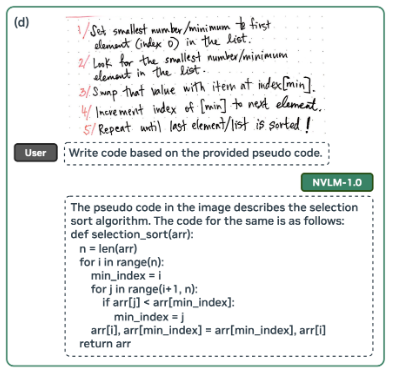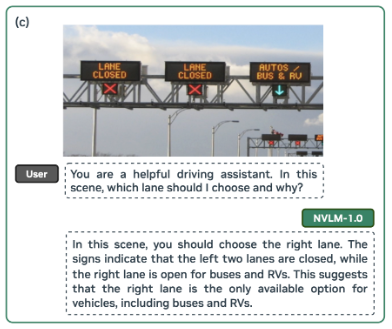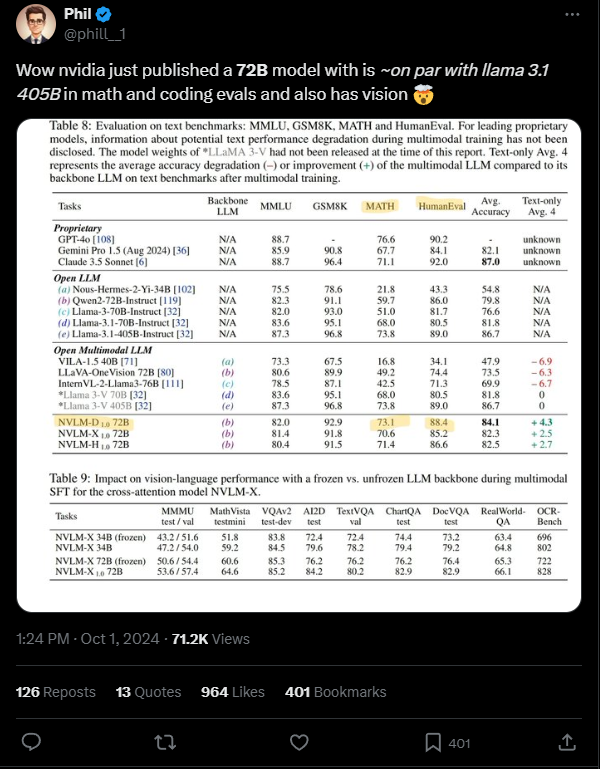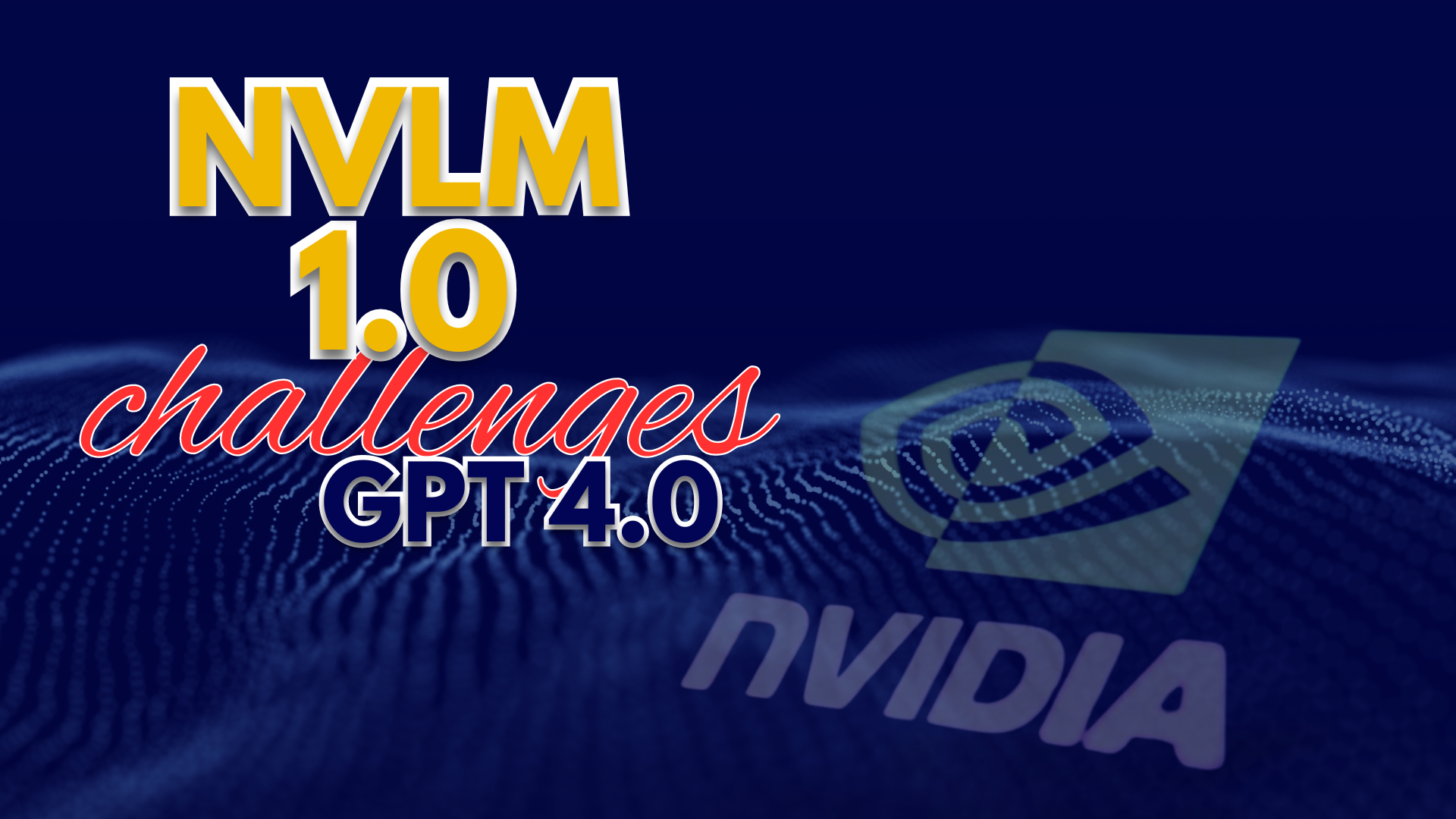Table of Contents:
Nvidia’s NVLM 1.0: A Game-Changer in Artificial Intelligence
challenging CHAT GPT-4
Nvidia has made a significant leap in the field of artificial intelligence with the release of its open-source NVLM 1.0 family of large multimodal language models. This new AI model is set to compete with proprietary systems from industry giants like OpenAI and Google, marking a pivotal moment in AI integration and AI data integration.
The NVLM 1.0 family, spearheaded by the 72 billion parameter NVLM-D-72B, showcases exceptional performance across both vision and language tasks. This model not only excels in multimodal tasks but also enhances text-only capabilities, making it a versatile tool for various applications. According to Nvidia’s researchers, “We introduce NVLM 1.0, a family of frontier-class multimodal large language models that achieve state-of-the-art results on vision-language tasks, rivaling the leading proprietary models (e.g., GPT-4o) and open-access models”.
Nvidia’s NVLM-D-72B model stands out as a versatile performer in the realm of artificial intelligence, showcasing impressive adaptability in processing complex visual and textual inputs. This model is part of Nvidia’s groundbreaking NVLM 1.0 family, which aims to revolutionize AI integration and AI data integration.
Nvidia’s release of NVLM 1.0 marks a pivotal moment in the evolution of artificial intelligence. By open-sourcing a model that rivals proprietary giants like OpenAI and Google, Nvidia isn’t just sharing code—it’s challenging the very structure of the AI industry.
Breaking the Mold: Open-Source AI
In a bold move, Nvidia has made the model weights publicly available and has promised to release the training code. This decision breaks away from the trend of keeping advanced AI systems closed, granting researchers and developers unprecedented access to cutting-edge technology1. This open-source approach is expected to accelerate advancements in AI integration and AI data integration, fostering innovation across the field.
Performance and Capabilities
The NVLM-D-72B model demonstrates impressive adaptability in processing complex visual and textual inputs. It can interpret memes, analyze images, and solve mathematical problems step-by-step. Notably, the model improves its performance on text-only tasks after multimodal training, a significant achievement as many similar models see a decline in text performance. The NVLM-D-72B increased its accuracy by an average of 4.3 points across key text benchmarks.

Exceptional Multimodal Capabilities
The NVLM-D-72B model excels in interpreting and processing a wide range of inputs, from visual data to textual information. Researchers have highlighted its ability to interpret memes, analyze images, and solve mathematical problems step-by-step. This versatility makes it a powerful tool for various applications, from content creation to data analysis. For instance, in the realm of visual tasks, NVLM-D-72B can accurately describe the content of images, making it useful for applications in digital marketing and automated content generation.


Enhancing Text-Only Performance
One of the most remarkable features of the NVLM-D-72B is its ability to improve performance on text-only tasks after undergoing multimodal training. This is a significant achievement, as many similar models tend to see a decline in text performance when trained on multimodal data. The NVLM-D-72B, however, increased its accuracy by an average of 4.3 points across key text benchmarks. This improvement underscores the model’s robustness and its potential for enhancing AI data integration in various fields, including natural language processing and automated coding.

Impact on AI Integration and AI Data Integration
Nvidia’s NVLM-D-72B model exemplifies its innovative approach to artificial intelligence (AI) integration. By merging visual and textual training, Nvidia has developed a model that excels in multimodal tasks and enhances text-only scenarios. This dual proficiency is particularly valuable in industries like e-commerce, where both product descriptions and images are crucial.

The open-source nature of Nvidia’s NVLM models significantly impacts AI integration and AI data integration. Researchers and developers can now explore new applications and improve existing ones by leveraging these advanced capabilities. This could lead to significant advancements in natural language processing, computer vision, and automated coding.

AI Nvidia’s bold move to open-source its models could spark a chain reaction across the tech industry. Other tech leaders may feel pressured to open their research, potentially accelerating AI progress. By leveling the playing field, Nvidia enables smaller teams and independent researchers to innovate with tools once reserved for tech giants. This democratization of AI technology could lead to a surge in creative solutions and advancements in AI integration and AI data integration.

Accelerating AI Research and Development
Nvidia’s decision to make such a powerful model openly available is poised to accelerate AI research and development across the field. By providing access to a model that rivals proprietary systems from well-funded tech companies like OpenAI and Google, Nvidia is enabling smaller organizations and independent researchers to contribute more significantly to AI advancements. This open-source approach is expected to foster innovation and collaboration, breaking down barriers that have traditionally limited access to cutting-edge AI technology.
Innovative Architectural Designs
The NVLM project introduces several innovative architectural designs, including a hybrid approach that combines different multimodal processing techniques. This development is particularly noteworthy as it could shape the direction of future research in the field of artificial intelligence. By integrating various processing techniques, Nvidia’s NVLM models are able to handle complex tasks that involve both visual and textual data, enhancing their versatility and performance.
Balancing Innovation and Ethical Concerns
The true impact of NVLM 1.0 will unfold in the coming months and years. It could usher in an era of unprecedented collaboration and innovation in artificial intelligence. By providing access to a model that rivals proprietary systems, Nvidia is enabling a broader range of contributors to advance AI research and development. This move is expected to drive significant progress in areas such as natural language processing, computer vision, and automated coding.
However, the release of NVLM 1.0 isn’t without its risks. As powerful AI becomes more accessible, concerns about misuse and ethical implications are likely to grow. The AI community now faces the complex task of promoting innovation while establishing guardrails for responsible use. This includes addressing issues such as data privacy, algorithmic bias, and the potential for AI to be used in harmful ways.
Nvidia’s decision to open-source NVLM 1.0 also raises important questions about the future of AI business models. If state-of-the-art models become freely available, companies may need to rethink how they create value and maintain competitive edges in AI1. This could lead to new business strategies focused on services, customization, and integration rather than proprietary technology.
Community and Industry Impact
The AI community has responded positively to Nvidia’s open-source initiative, particularly the NVLM-D-72B model. One AI researcher noted on social media,
“Wow! Nvidia just published a 72B model that is on par with Llama 3.1 405B in math and coding evaluations and also has vision capabilities”.
This sentiment reflects the broader optimism among AI researchers and developers who see this as a significant step forward in AI integration and AI data integration.

The release of Nvidia’s NVLM 1.0 family of large multimodal language models has sparked widespread excitement within the artificial intelligence community. By providing access to a model that rivals proprietary systems from well-funded tech companies, Nvidia may enable smaller organizations and independent researchers to contribute more significantly to AI advancements. This positive reception highlights the potential for Nvidia’s open-source models to democratize access to cutting-edge AI technology, enabling smaller organizations and independent researchers to make meaningful contributions to the field of artificial intelligence.
AI Nvidia’s bold move to open-source its models could spark a chain reaction across the tech industry. Other tech leaders may feel pressured to open their research, potentially accelerating AI progress. By leveling the playing field, Nvidia enables smaller teams and independent researchers to innovate with tools once reserved for tech giants. This democratization of AI technology could lead to a surge in creative solutions and advancements in AI integration and AI data integration.
Future Prospects
Nvidia’s NVLM 1.0 is set to revolutionize the artificial intelligence landscape. Its open-source nature and exceptional performance in both vision and language tasks position it as a formidable competitor to established models like Chat GPT and GPT-40. As AI integration and AI data integration continue to evolve, NVLM 1.0 stands out as a beacon of innovation and accessibility in the artificial intelligence domain.
The NVLM-D-72B model, part of Nvidia’s NVLM 1.0 family, is poised to play a significant role in shaping the future of artificial intelligence. Its exceptional performance in both visual and textual tasks positions it as a strong competitor to established models like Chat GPT. With ongoing developments in AI integration and AI data integration, Nvidia’s NVLM-D-72B stands out as a beacon of innovation and accessibility in the artificial intelligence landscape.
Nvidia’s bold move to open-source its NVLM 1.0 models could spark a chain reaction across the AI industry. This democratization of AI technology enables smaller organizations and independent researchers to innovate with tools once reserved for tech giants. As AI integration and AI data integration continue to evolve, the NVLM 1.0 models stand out as beacons of innovation and accessibility in the artificial intelligence landscape.




